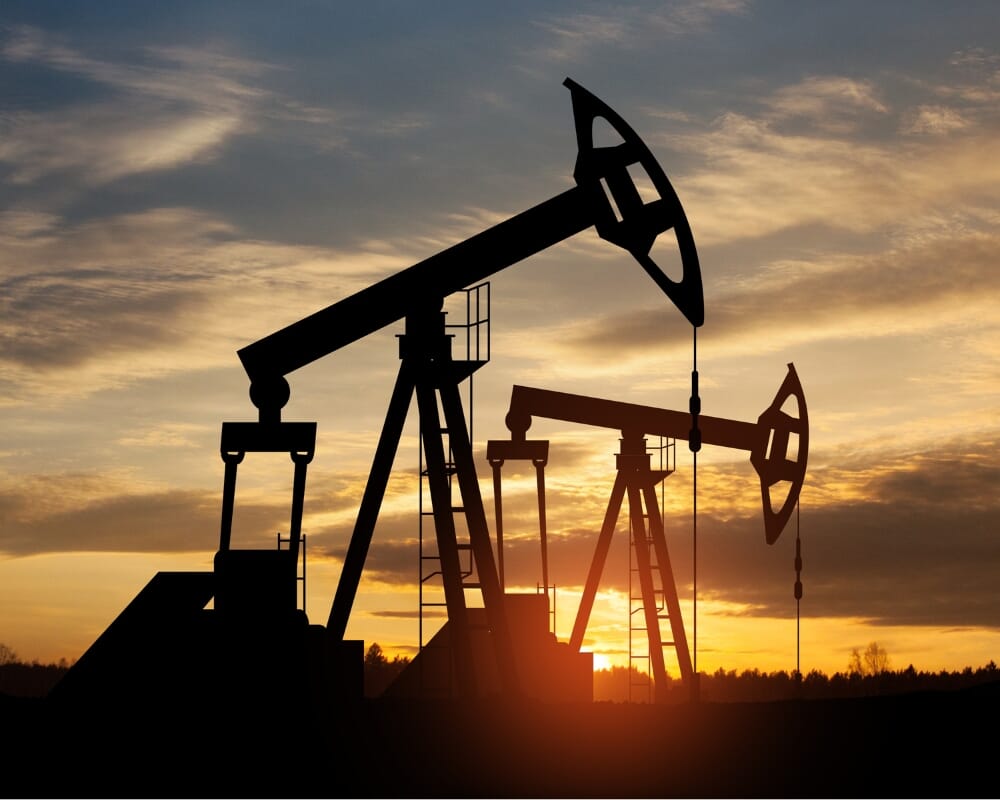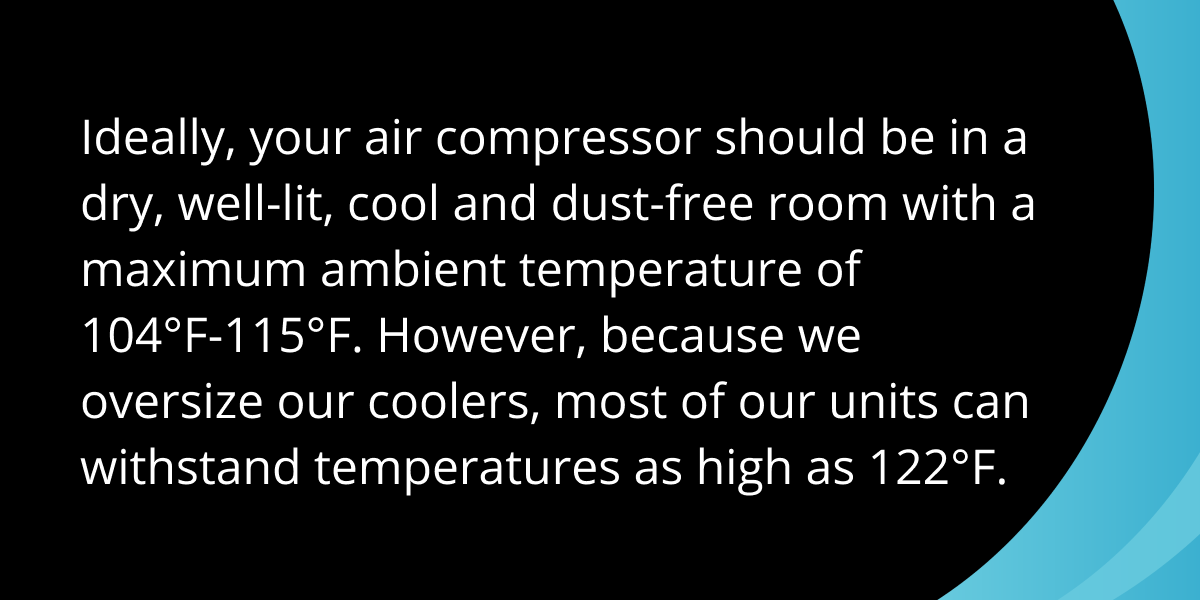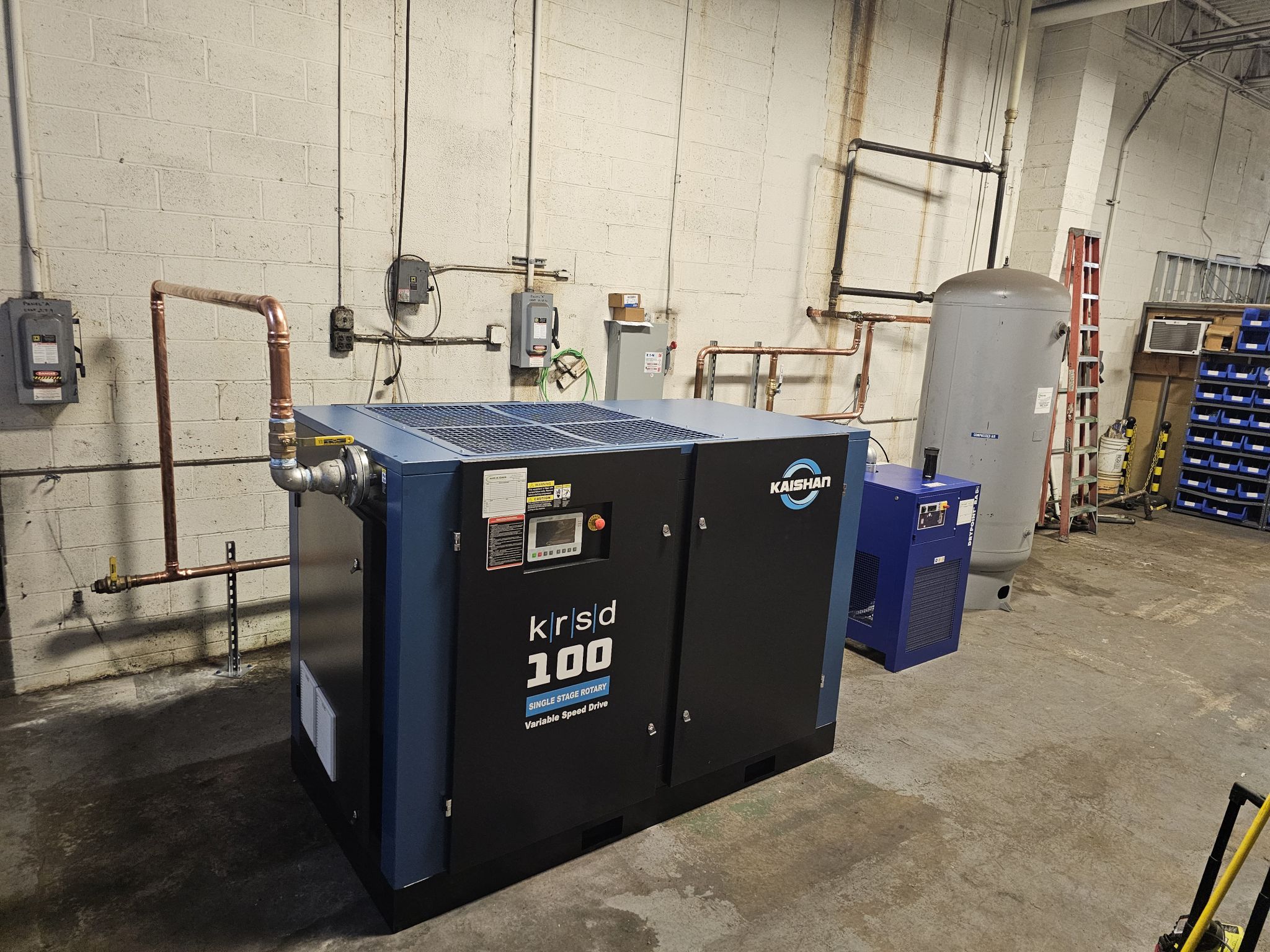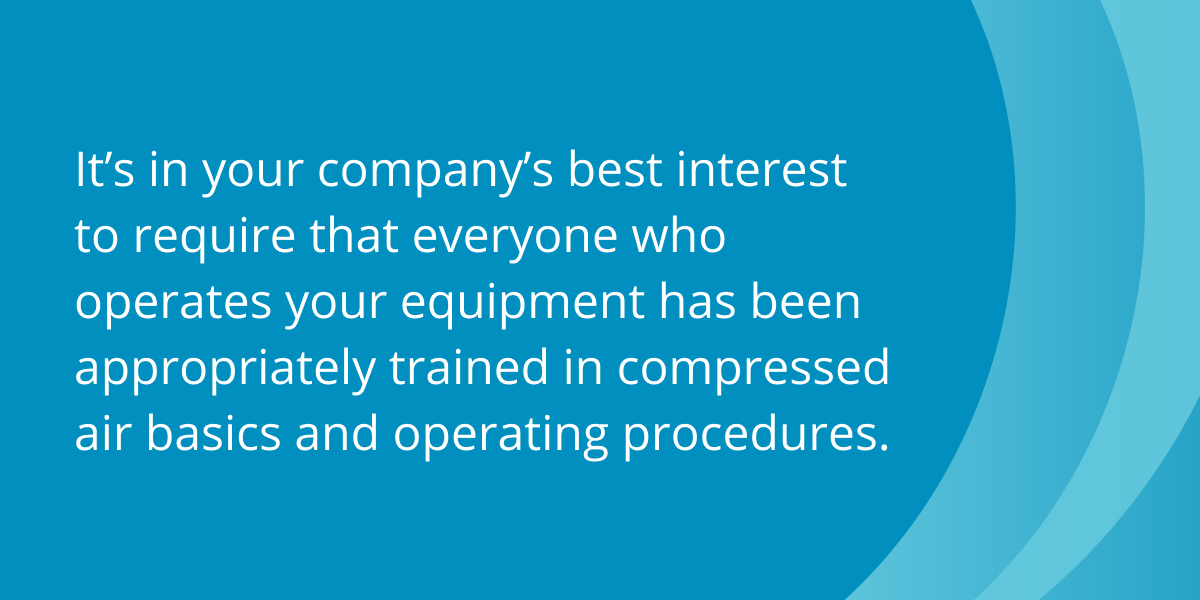
What Is a Motor-Driven Air Compressor, And How Does It Work?
March 5, 2025
A Beginner’s Guide to Reading Rotary Screw Compressor Performance Curves
March 19, 2025Ultimate Guide to Rotary Screw Air Compressor System Design, Part Two: Eight More Questions About Deploying a New System
Kaishan USA | March 12, 2025| Uncategorized

You can locate air compressors outdoors in more moderate climates, such as the Lake Ray Hubbard Power Plant in Sunnyvale, Texas. But you should take proper precautions to protect them from the elements.
In part one of this series on designing compressed air systems (“Ultimate Guide to Rotary Screw Air Compressor System Design, Part One”), we posed several questions about specifying and buying an air compressor.
This post will focus on the equally significant conclusion of the system design process: deploying that new compressor. We’ll address how it will fit into your facility and provide the air pressure, flow and quality you need.
As before, we have divided our eight final questions into three categories: location, system layout and operation and maintenance.
Once again, if you missed the first part of this series, you can find it here: “Ultimate Guide to Rotary Screw Air Compressor System Design, Part One.”
We’ll start with location.
Location
1. Where Is the Best Place to Put a Compressor?
In more moderate climates, like the southeastern and southwestern states of the United States, you can locate an air compressor outside. Putting it outside is a great way to reduce noise and ensure a supply of fresh, clean, cool air.
You’ll want to protect it from the elements, temperature extremes, prevailing winds and direct sunlight. If your air compressor has a variable-speed drive, you’ll want to take special care to protect it.
However, indoor locations are preferable. In a perfect world, your air compressor would be installed in a clean, dust-free, dry and oil-free area. The area would be relatively cool and adequately ventilated. There would be good lighting and enough space to allow maintenance access—preferably three feet of open space around the unit.
The compressor would rest on a concrete floor that is flat and level and can handle the unit’s weight. The floor should be flat and level concrete that can handle the static weight of the unit. If the floor surface is uneven or irregular, install it on a 5- to 15-mm pad made of rubber or other pliable material. Do not bolt down to the floor.
For more on the ideal location for a compressor, see our blog post, “How To Design And Prepare For an Industrial Air Compressor Installation.”
2. Can I Place My Compressor in an Equipment Room?
Because air compressors run hot, they should not be in the same room as any device that generates heat, such as a boiler. You can place more than one compressor in the room, but make sure one compressor does not blow exhaust air onto another.
Ideally, your air compressor should be in a dry, well-lit, cool and dust-free room with a maximum ambient temperature of 104°F-115°F. However, because we oversize our coolers, most of our units can withstand temperatures as high as 122°F. For more details, see our blog post, “Hot Weather Impacts on Air Compressor Systems.”

Locate the unit centrally, as close as possible to the tools it’s intended to service. That will reduce the amount of piping required, thereby avoiding the leaks and pressure drops that sometimes occur in long piping runs.
Place your compressor at least three to four feet away from walls or other equipment to allow for maintenance and service. You should also have at least five feet of clearance above your compressor. If the ceiling is lower than that, the air could circulate back into your compressor after discharge. Ventilation hoods are available to redirect the cooler discharge air flow and ensure the exhaust air does not recirculate.
For more information on compressor room design, read our blog post, “Compressor Room Design.”

As this installation by Kaishan distributor Air & Gas Technologies shows, you’ll want to locate your new compressor at least three feet away from walls and other equipment. And ensure there’s ample space above the compressor. (Photo courtesy of Air & Gas Technologies)
3. How Do I Get Rid of the Heat My Compressor Generates?
Removing heat is extremely important for the reliability and longevity of your compressor. Excessive heat will break down the oil in the compressor and reduce the oil’s ability to protect the system’s moving parts.
Compressors alone produce 17,522 BTU/hour for every 1 HP. So, the goal is to remove all that heat generated during compression and keep it from recirculating back into the room.
You’ll want to get clean air into your compressor with no restrictions. You can use louvered vents or forced ventilation. Ducting discharge air out. Bringing clean air in. That’s the perfect combination for a compressor.
If you’re using water cooling, you’ll need to have water available. You may have to treat the water chemically to keep it clean.
In northern climates, it’s possible to save significant amounts of energy by recovering the heat removed from the compressed air system in the winter. In the summer, a damper directs the air toward an outside vent. In the winter, the air is used for space heating or preheating other operations.
You can find out more about the importance of cooling in our blog post, “Air Compressor Cooling.”
After determining your location, you can focus on your system layout.
System Layout
4. What’s the Best Way to Lay Out My Compressed Air System?
The layout of the compressed air piping in your plant can significantly impact your system's operation. A faulty design will increase energy costs, equipment failure, production losses and maintenance. Meanwhile, investing in a well-crafted layout will have substantial payback over the life of the system.
It’s usually best to start with a loop system, in which the air flows in two directions. This design reduces pressure drop throughout the system and ensures the full air flow arrives at all your equipment downstream.
Your primary goal will be reducing turbulence, the interrupted airflow that occurs when the flowing air needs to navigate around direct interference, such as sharp turns or changes in direction, or indirect interference, such as weak velocity, improperly sized pipes or obstructions.
As far as the piping itself, metal pipe—black iron, copper, stainless steel or aluminum—is the best choice because of price and durability. You’ll want to make sure you have the proper pipe size to avoid pressure restrictions. And make sure that you take into account the number of compressors to minimize pressure drop. For more on piping selection, see our blog post, “Reduce Energy Costs: Four Tips for Plant Managers.”
5. How Can I Reduce Downtime?

It always helps to have a backup, as Dakota Fluid Power did in this installation.
We often encourage customers to adopt at least a three-compressor approach involving base, trim and backup units.
- A base load compressor to meet your system’s minimum compressed air load. Its output does not fluctuate as demand goes up and down. Instead, it runs full bore—at 100% capacity—or turns off. Depending on variations in your demand, you may have more than one unit as a base load.
- A trim compressor to handle fluctuations in demand above the base unit. Since the level of flow needed will rise and fall depending on the needs of your system, rotary screw compressors equipped with variable-speed drives are a natural for this application.
- A backup compressor on standby if a base or trim unit goes offline. To fill in appropriately, it should be the same size as the base load compressor.
Configuring your compressed air system in this way virtually eliminates unplanned downtime, which, in the real world, is the biggest (and most avoidable) expense associated with your compressed air system. A highly reliable rotary screw air compressor always waits in the wings as a backup should a base load or trim unit fail, keeping both pressure (PSIG) and flow (CFM) more consistent and reliable.
While you may be reluctant to invest in additional units, remember that equipment costs represent only 12% of the total lifetime costs of owning an industrial air compressor, according to the U.S. Department of Energy.
For more information on using a multiple-compressor system to eliminate downtime, see our blog post, “Four Reasons Your Plant Needs a Backup Air Compressor.”
Your system layout established, you should finally think about how your compressed air system should be operated and maintained.
Operation and Maintenance
6. How Do I Get Started?
First, it’s in your company’s best interest to require that everyone who operates your equipment has been appropriately trained in compressed air basics and operating procedures. If you need training materials, check out our safety video.

Second, make sure all your operators have appropriate personal protective equipment, including goggles, masks, gloves (rubber or leather), steel-toed shoes and leather or PVC aprons.

Safety is no accident. Make sure your workers have the appropriate PPE when they are working around your compressor.
Before starting your air compressor, you should do a brief walk-around, as you would when operating a forklift. Make sure all the safety guards and warnings are still in place and that you have lock-out/tag-out isolation.
If you want to learn more about safely operating your compressor, check out our blog post, “Four (and a Half) Critical Compressed Air Safety Tips.”
7. It’s a New Compressor. Why Do I Need a Maintenance Program?
If you want to keep your new air compressor running reliably and efficiently, it’s a good idea to take air compressor maintenance seriously from the start. Industry research has shown that a proactive maintenance strategy can help you reduce maintenance costs by as much as 70%.
We strongly recommend that you follow your original equipment manufacturer’s maintenance guidelines to maintain the integrity of your air compressor system and allow it to achieve the performance level you expect.
Using generic aftermarket parts, for example, could ultimately raise your lifecycle costs, resulting in higher energy use, increased downtime and more frequent replacements. As Compressed Air Best Practices notes, “The money you save by purchasing generic parts is often the most expensive money you will ever save.” Most OEMs require that you use their parts to maintain warranty protection.
For the critical air compressor maintenance steps you’ll need to address regularly, see our blog post, “What You Need to Know About Rotary Screw Compressor Maintenance.”
The Help You Need to Get the Performance You Deserve
Working with a compressed air professional is the best way to achieve the air compressor performance you want. We work with a nationwide network of independent distributors, because it's the best way to ensure you get the right system, reliable service and quick access to parts when you need them most.

The best way to get the results you want is to work with a compressed air professional to maximize air compressor performance.
Unlike large corporate suppliers, there's no red tape; our distributors offer expert guidance, faster response times and personalized support tailored to your needs. They don't just sell compressors—they build relationships.
With factory-trained technicians and a deep understanding of industrial applications, they help maximize efficiency and minimize downtime. So, when you buy through Kaishan, you're getting a local partner who cares about your business and seeing it succeed.
Key Takeaways
- You can place a compressor outdoors with proper precautions.
- The best location for a compressor is in a separate enclosure that is clean, dust-free, dry and oil-free.
- Ventilation is critical in getting rid of the heat your compressor generates.
- Most facilities find that a loop structure is the best way to lay out their compressed air system.
- The best way to reduce downtime is to configure your compressors in a multiple-compressor configuration with base, trim and backup units.
- Make sure all operators are trained in compressor operation and that all safety equipment and warning labels remain attached after your compressor is installed.
- The best way to maintain your compressor is to follow the manufacturer’s recommendations carefully.
- Using original OEM parts will improve operation, avoid hazards and maintain warranty protection.
- Maintenance is as essential with a new compressor as with an older machine.
Let Us Help
Proper air compressor system design is critical to the operation of your compressed air system and all the processes that rely on that system. If you need help designing a compressed air system that meets your needs, get in touch with the experts at Kaishan. Contact us today.
Listen to the Podcast Version
Optimizing Compressor Placement
Alright, so compressors—Wait, Jason, before we get started, one thing that I just realized...we're now TEN episodes in with the Big Dog podcast!
10? Already? Wow! I couldn't have done without you, Lisa. And our valued listeners, of course.
The feeling is mutual, Jason! Now, let's keep a good thing going!
Alright, so, as I was saying, compressors are the backbone of production, but let’s be honest, placement is one of those things people either overthink or totally ignore. Let’s cut through it. What makes an indoor spot ideal for one of these things?
Well, the best-case scenario? It’s gotta be a clean, dry, and well-ventilated area with enough room for maintenance. Like, three feet around the unit, minimum. And ambient temps should stay under 115 degrees, ideally much cooler.
Right, and if it’s outdoors?
You can pull that off in moderate climates. But you’ve gotta shield it from, like, wind, rain, and direct sunlight—and watch out for extreme temps because that can totally wreck efficiency. Oh, and if it has a variable-speed drive, you need extra protection for that.
Okay, so indoor’s preferable. But what happens if you botch the placement? You know, stick it somewhere less than ideal.
Oh, it’s not pretty. For starters, poor air circulation means you’ve got heat piling up, which kills the system’s oil faster. And then maintenance? A nightmare. I mean, I’ve seen a compressor shoved into a cramped, dusty corner of a boiler room—
Wait, in a boiler room?
Yeah, I know, right? And not only was it impossible to get proper clearance for servicing, but the heat from the boiler... let’s just say it didn’t help. The thing ran like a sloth on a treadmill—super inefficient.
Sounds like they were asking for a failure. So, how do you juggle maximizing space while still giving this thing room to breathe?
It’s tricky, but you’ve gotta prioritize performance over convenience. Like, yeah, it might be tempting to cram it somewhere out of sight, but cutting corners now usually means bigger headaches later. And think about your piping flow—central placement near your tools really helps reduce pressure drops.
Alright, so skipping on placement prep is basically skipping on efficiency and reliability. Good to know.
Designing Efficient Air Systems
So now that we’ve covered placement, let’s switch gears to airflow. Compressed air systems thrive on smooth airflow, right? Let’s dive into loop structures—why is a loop better than just running the pipes straight to the tools?Simply put, a loop structure keeps the airflow balanced. It means air can move in both directions, so there’s less turbulence and fewer pressure drops. Picture this—you’ve got air flowing through a straight line, and suddenly there’s a sharp corner. That’s turbulence.
Oh, I get it. It’s like an irrigation system, right? You can’t just have all the water flow down one section and expect even coverage. A loop spreads it out evenly across the whole field.
Exactly, and for compressed air, that even flow means tools downstream get the pressure they need without wasting energy pumping air through long, obstructed pipes.
So build a loop system and avoid bottlenecks. Got it. Now, downtime’s a killer for plants. What’s this multi-compressor setup I keep hearing about?
Oh, yeah, the base, trim, and backup approach. It’s a game-changer. Here’s how it works—a base compressor handles your minimum load, always running at full capacity. Then there’s the trim compressor, which picks up the slack during peak demand. And a backup? That’s your fail-safe, kicking in if one of the others goes offline.
Wait, so how does this actually help with uptime?
Think about it—if one compressor goes down, the backup steps in seamlessly. I’ve seen places ignore this and, uh, yeah, one compressor failure brought the whole line to a halt. Massive production losses, frantic scrambling. It’s bad.
Yeesh, sounds like insurance for your productivity, really. But what about managing heat? These machines throw off a ton of it, right?
Oh, absolutely. A single horsepower generates around 17,000 BTUs of heat per hour—so yeah, it stacks up. Good ventilation is non-negotiable.
So, what’s the move? Just slap some fans in there?
Well, fans are part of it, but you’ve gotta think bigger. Louvered vents? Great for bringing fresh air in. Ducting? Perfect for routing hot air out. And if it’s water-cooled, you’ve gotta keep that water clean, maybe even treated.
Right, and in colder climates, you can reuse that heat, can’t you?
Exactly. Instead of wasting it, you can use the heat to warm other areas in winter. It’s an efficiency two-for-one—better for your compressor and for your energy bills.
Maintenance Essentials for Longevity
Alright, we’ve talked about maximizing efficiency, from airflow to heat management. Now let’s shift to the glue that holds it all together—maintenance. It’s not the most exciting topic, but skip it, and all those efficiency gains? Gone. So, what’s the number one thing people tend to miss here?Honestly? Thinking a new compressor doesn’t need as much attention. I mean, I get it—it’s brand new, everything’s working like a dream. But skipping regular maintenance early on can lead to big headaches later. It’s, uh, kind of a ticking time bomb.
Right, and then you’ve got shortcuts—generic parts, cheaper oil... people trying to save a buck. What’s the real cost of that?
Oh, it adds up fast. First off, the manufacturer’s warranty? Poof, gone. And those generic parts? They might seem fine at first, but they’ll burn out faster, or worse, mess with the system’s efficiency. You save today, but you’re spending tomorrow on downtime and repairs.
So, OEM parts aren’t just a gimmick—they’re like insurance for your equipment’s performance?
Exactly, and it’s not just parts. Maintenance has to match the manufacturer's guidelines, or you lose that performance edge. These machines are precise—treating them like they’re replaceable is, uh, just plain reckless.
That’s harsh, but fair. And what about training? Operators play a big role in keeping these things running, right?
Oh, 100%. I’ve seen how training—or the lack of it—can make or break a system. Real quick—there was this shop I visited. They had a newer guy on maintenance, but no one had properly trained him. During a routine check, he kinda skipped a lock-out-tag-out. Nearly turned into a mess. Thankfully, someone caught it in time.
Whoa. So, it’s not just about technical problems—it’s about avoiding accidents that could’ve been prevented with proper training.
Exactly, and it’s not just the operators—teamwide awareness of safety protocols makes a huge difference. Training pays for itself in fewer accidents and smoother operations.
Alright, it’s clear—take maintenance seriously, follow the OEM’s plan, and don’t cheap out on shortcuts. Efficiency costs up front, but the long-term payback is worth it.
Totally. Proper care doesn’t just save you money; it keeps your compressors running like they should—reliable and efficient—for years to come.
And that’s why maintenance isn’t optional. On that note, we’re wrapping this up. Thanks for tuning in, everyone, and stay sharp out there!
Yeah, keep those compressors humming. Catch you next time!
Random stat or
customer quote
textXXtext
text

